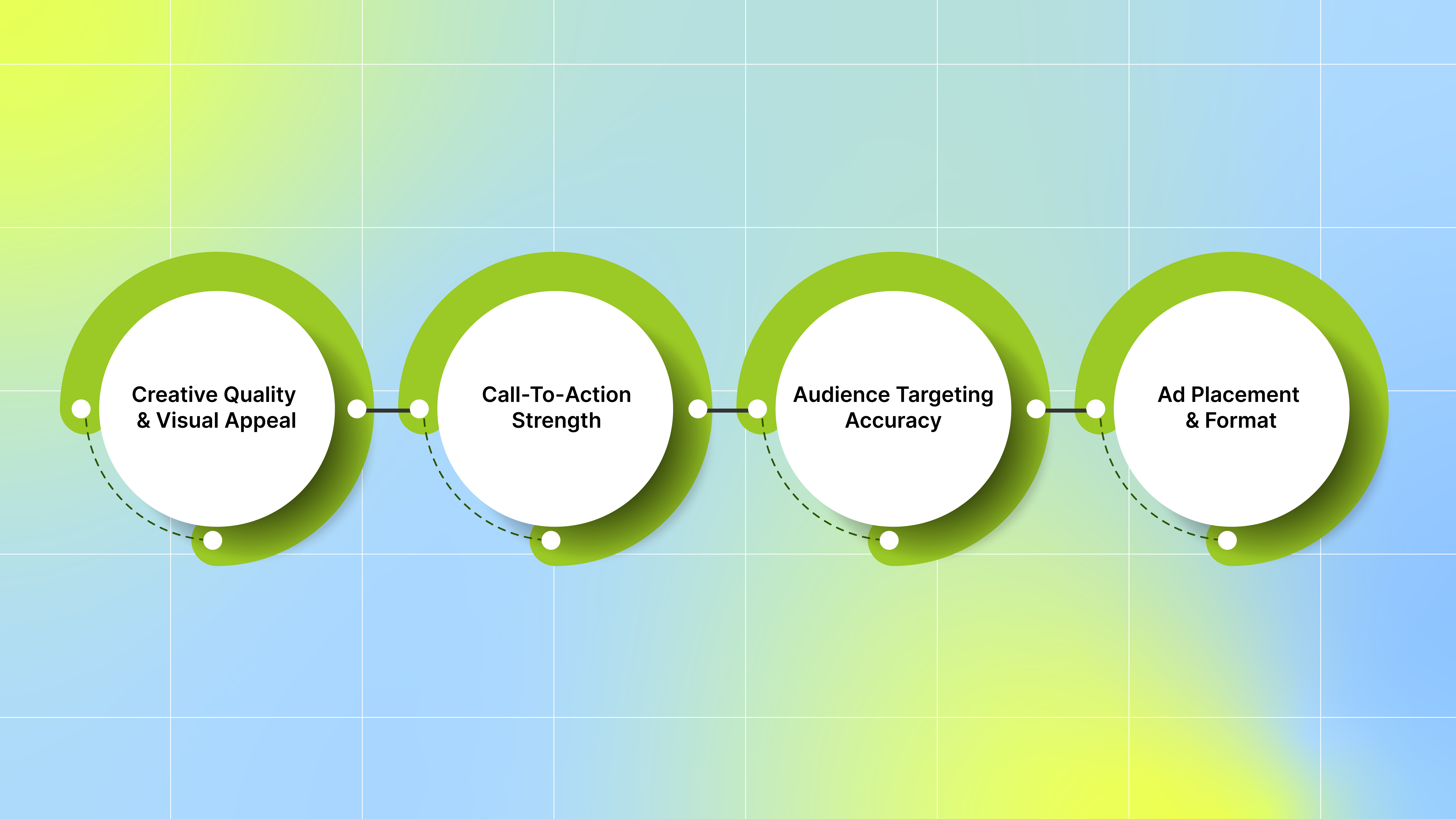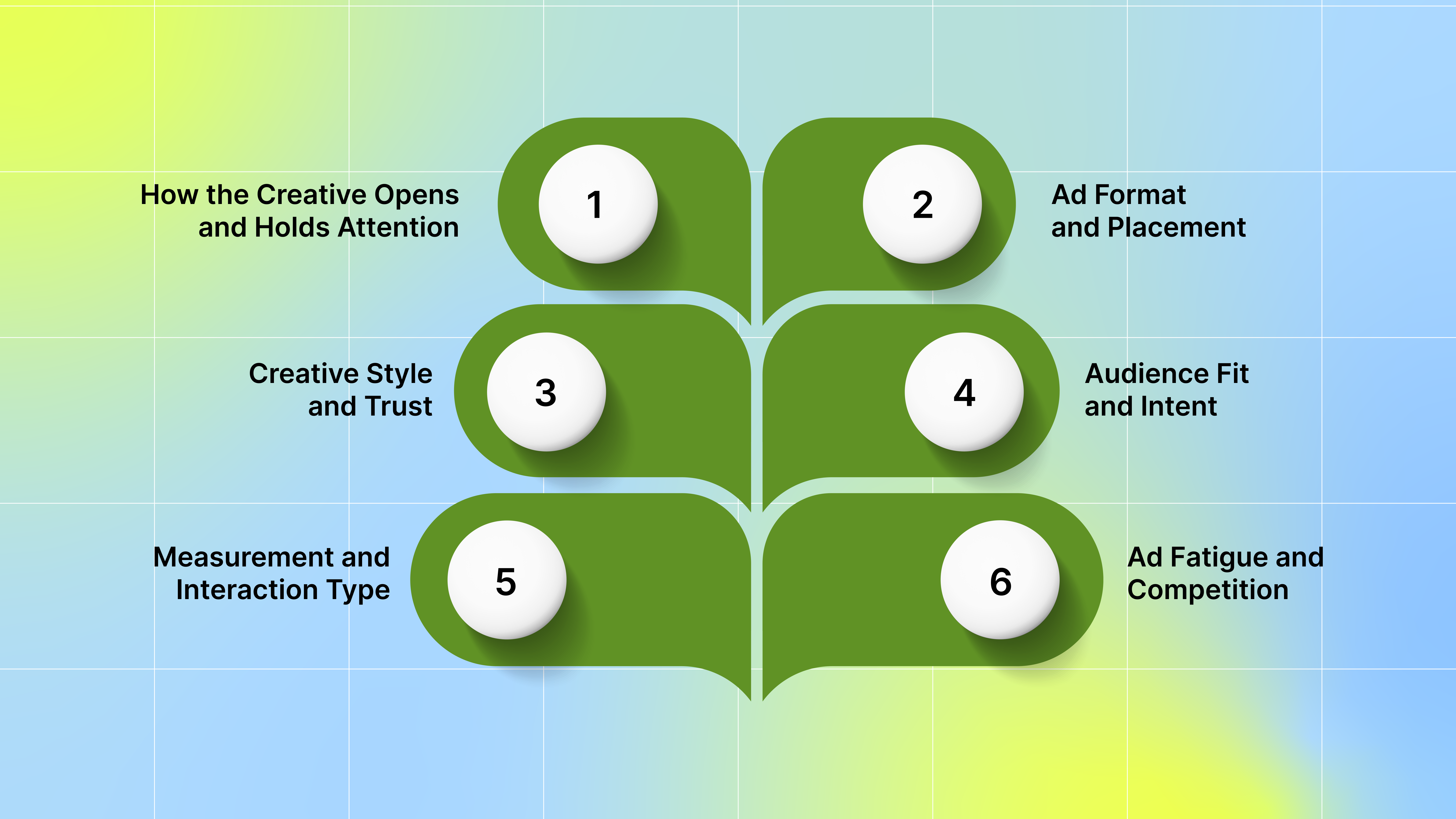Tracking TikTok Ads Benchmarks: What’s a Good CTR?
You run paid campaigns on TikTok and need a clear way to judge whether your ads are performing well. The question “What is a good CTR for TikTok ads?” keeps coming up, yet most answers are outdated or too vague to use as a real benchmark.
That uncertainty costs money. If your target CTR is too low, you miss the chance to strengthen creatives and attract better users. If it’s unrealistically high, you waste time chasing numbers that don’t reflect how TikTok actually works. Since ad formats, placements, and audiences vary widely, no single CTR fits every campaign, but having the right reference points helps you test and scale with intent.
In this blog, we’ll break down what CTR means for TikTok ads, why it matters for campaign results, and how different factors like creative quality, format, and audience shape it. You’ll see current CTR benchmarks for 2025 by ad type and industry, how TikTok compares to other platforms, and practical ways to improve CTR through creative and targeting adjustments.
What Does CTR Mean on TikTok Ads?
CTR (click-through rate) is the share of people who click your ad after seeing it. TikTok reports clicks as different fields (for example, Clicks (all) and Clicks (destination)). Clicks (all) include all user interactions, while Clicks (destination) count only those leading to your intended landing page, helping you measure meaningful engagement aligned with campaign goals. For traffic-focused campaigns, select the metric that aligns with your goal in TikTok Ads Manager, and use it to calculate CTR.
Formula:
CTR = ( clicks ÷ impressions ) × 100
One quick example: if an ad gets 450 clicks from 60,000 impressions, CTR = (450 ÷ 60,000) × 100 = 0.75%.
Now that the metric is defined, the next step is understanding why it influences campaign outcomes.
Why CTR Matters for TikTok Campaign Performance
CTR is a quick, action-driven indicator of how effectively an ad attracts viewers. Read these five practical reasons why you should pay close attention to it:
Shows interest quickly: A strong CTR means the creative caught attention and motivated action, whether that’s a click to learn more or a visit to your page. It’s the clearest early sign that your message connected.
Tells you if the creative fits the audience: If the same creative gets very different CTRs across audiences, the match between message and audience likely needs tuning. Testing different creative and audience pairs helps identify where the fit is strongest.
Affects delivery and cost: Platforms tend to reward ads that drive engagement. High-performing creatives often earn better placements or lower effective costs, improving campaign efficiency.
Benchmark for goal setting: Use industry medians to set realistic targets, then test and beat them with creative and targeted experiments.
Guides following tests: Use CTR as an early filter. Creative ideas that lift CTR are worth scaling and testing for conversions, while low CTRs should be refreshed or re-targeted.
In short, CTR connects creative performance with campaign outcomes. It helps spot what’s working early, direct testing toward ideas with real potential, and keep budgets focused on ads that attract genuine interest.
Key Factors That Affect TikTok Ad CTR

Several factors directly shape how often viewers click on a TikTok ad:
1. Creative Quality and Visual Appeal
The first one to three seconds decide whether people keep watching or scroll away. Strong opening visuals or a striking action make viewers more likely to stay long enough to see the click cue, while weak or slow starts cause quick drop-offs and shrink the potential audience. Clips that feel native and use clear, readable on-screen text make the click signal more noticeable and prompt more taps.
2. Call-To-Action Strength
The CTA sets the viewer’s expected next step upon seeing the ad. When the action cue is clear and easy to recognize, more viewers understand it as an immediate chance to act and are likely to tap. If the CTA is vague or missing, viewers hesitate, and fewer click through. Its visual prominence and timing both affect how many people notice it as the next step.
3. Audience Targeting Accuracy
Targeting decides whether the people who see an ad are genuinely interested in its message. When the audience aligns with the ad’s appeal, a larger share of impressions turns into qualified clicks. If the match is weak, impressions still count, but clicks decline because the content doesn’t align with the viewer’s intent or context. Shifts in audience composition, then, change CTR by affecting the balance between receptive and unreceptive viewers.
4. Ad Placement and Format
Different placements change how users engage and what mindset they’re in. Ads shown in the feed or as boosted creator posts reach people in a browsing mode, where interaction feels natural. The same creative can perform very differently in high-impact reserved spots that appear at app open. Delivery context, including autoplay with sound, full-screen timing, and how the format blends with organic content, directly shapes how many viewers notice and respond to the ad.
Together, these factors shape how efficiently an ad turns attention into action, making CTR both a creative signal and an operational metric that helps decide what to keep, change, or scale next.
After covering the factors that shape CTR, the next question is what numbers you can use as benchmarks when reviewing your own results.
Also Read: How to Create and Optimize TikTok Playable Ads?
What’s Considered a Good CTR on TikTok?
A practical baseline for TikTok ad CTR in 2025 sits around 0.7%–0.9%. Use that as your platform median when you compare campaigns. If a campaign is noticeably above this range, it means your creative or placement is working better than average.
1. CTR Benchmarks by Ad Format
Here are common TikTok placements and what to expect from each in 2025:
TopView (app-open takeover): ~12–16%. Appears full-screen when users open the app. High attention and engagement, but limited inventory and higher cost.
Brand Takeover (full-screen pre-feed): ~7–10%. Short full-screen creative that appears when users open the app. Strong reach for awareness and landing clicks.
In-Feed ads (native feed placement): ~1.5–2% average. Works best when the creative mimics normal TikTok posts (short, sound-on, UGC style). This is the most common placement you’ll test.
Spark Ads (promoted organic / creator posts): 3%+.Often beats branded creative because it preserves creator authenticity and social proof. Use Spark when you can run creator content that has already performed well.
These ranges are based on multiple 2025 benchmark reports. Pick formats that match your campaign goal, whether you need wide awareness or a performance-focused response, and align them with your budget.
2. CTR Benchmarks by Industry
Industry averages help you set realistic targets and spot performance gaps. If your numbers fall short, start by testing new creative angles or placements.
Industry | Typical CTR (2025) |
|---|---|
Finance & Industrial | ~1.03% |
EdTech | ~0.89% |
Technology (Software / Tech) | ~0.26% |
Fashion | ~0.25% |
Beauty | ~0.32% |
Food & Beverage | ~0.84% |
Fitness & Wellness | ~0.6% |
Use these as directional benchmarks, not strict goals. Regional performance and offer type can shift these baselines meaningfully.
TikTok CTR vs. Other Advertising Platforms
Platform | Typical CTR range (2025) | Best-performing format(s) | Top CTR potential |
|---|---|---|---|
TikTok | 0.5% – 1.0% (platform median ~0.7–0.9%). | In-Feed (native), TopView, Spark Ads. | TopView / Brand Takeover: up to ~12–16% in strong cases. |
Facebook / Meta | ~0.7% – 1.6% (varies by objective; traffic campaigns can be higher). | Feed ads, Collection, Video for traffic objectives. | Some traffic-focused setups are 1.5%+ (industry-dependent). |
YouTube | ~0.5% – 1.5% depending on format (TrueView generally higher). | TrueView in-stream (skippable), Discovery. | TrueView can reach ~1–1.5% or more for strong creative/intent matches. |
~0.6% – 1.2% (feed vs Reels will vary). | Feed posts, Reels (UGC/creator-driven). | Creator or UGC-led Reels can exceed feed CTRs in some cases. | |
Google (Search vs Display) | Search: ~3% (all industries avg ~3.17%); Display: ~0.4–0.6%. | Search ads (high intent) vs display banners (low intent). | Search ads often top single-digit CTRs in niche/high-intent queries. |
CTR averages differ by campaign objective (brand, traffic, or conversions), creative type, and region, so always benchmark against comparable campaigns.
The difference in CTR across platforms isn’t random. TikTok’s feed structure and engagement patterns explain the gap.
Why TikTok CTR Looks Different Than Other Channels
TikTok’s feed is content-driven and motion-first, so attention span and visual rhythm shape click behavior. Ads that feel native to the feed and spark interest within the first few seconds usually see stronger CTRs. Premium placements like TopView and Brand Takeover often get higher engagement because they appear full-screen before any scrolling starts.
Google Search campaigns work on active intent, where users are already looking for something specific, which is why their CTRs tend to be much higher. Social and short-video platforms operate on passive discovery, so performance leans more on how well the creative connects rather than on search intent.
When reviewing results, compare your CTR to TikTok’s platform median (0.7–0.9%) and the ranges for your format and industry. If your numbers fall below these baselines, begin by refreshing your creatives or testing different placements. These changes usually lead to the quickest lift.
Even within TikTok, CTR shifts between campaigns. These differences usually trace back to how the creative opens, where it appears, and who sees it.
Also Read: Why TikTok Ads Are Not Spending: 8 Solutions
Why CTR Benchmarks Differ Across Creatives, Placements, and Audiences

CTR changes because people see and react to ads differently. Below are the main reasons you’ll see different CTRs and quick actions you can run to learn what works for your campaigns:
1. How the Creative Opens and Holds Attention
The first 1–3 seconds decide whether someone keeps watching or scrolls away. Strong, obvious hooks that match the viewer’s expectations raise clicks and watch time.
Action: run a short test that swaps only the 1–2 second opener (question vs. visual shock vs. product reveal) and compare CTRs.
2. Ad Format and Placement
Full-screen placements and branded-takeover style formats get more attention than smaller in-feed units, but they can cost more and reach a different mix of users.
Action: match format to the goal, use high-attention formats for awareness or short-term lifts, in-feed for scale and cheaper tests.
3. Creative Style and Trust
Authentic-feeling clips from creators or real users usually get higher engagement than highly produced spots.
Action: A/B test creator-driven clips against studio-produced versions and scale the format that gets the better CTR. TikTok’s own creative reports show that creator variety often raises campaign performance.
4. Audience Fit and Intent
A tight audience that already wants the product will click more than a broad audience.
Action: test interest segments, lookalikes, and custom lists in separate ad groups and compare CTR by segment.
5. Measurement and Interaction Type
Different placements drive different actions (taps, link clicks, or swipes), and platform reporting varies accordingly.
Action: pick the metric that matches the desired user action, track link clicks when you want site visits, taps when you want deeper in-app activity.
6. Ad Fatigue and Competition
Seeing the same creative too often, or competing with many similar ads, will lower CTR.
Action: refresh or rotate creatives regularly, and monitor frequency and CTR together.
If you want to apply these actions efficiently with confidence, use a creative analytics tool like Segwise to automate the steps. It auto-tags creative elementssuch as hook lines, characters, product shots, CTAs, on-screen text, and audio cues. Each of these tags is then mapped to performance metrics like ROAS, IPM, CTR, and CPA, and connects to major ad networks and MMPs so your tests and metrics live in one place. From there, you can automatically detect creative fatigue, spin up data-backed briefs, and generate the new creative variants you should test next, which makes the tips below faster to run and easier to scale.
Practical Tips to Increase CTR on TikTok Ads
Small creative or targeting tweaks often make the biggest difference in CTR. The steps below are simple to test, measure, and repeat without changing your entire setup.
1. Design Scroll-Stopping Visuals
Why: The first 1–2 seconds grab attention.
Action: Start with a bold visual or quick question, use close framing, and add readable captions so the message works with and without sound. Check top-performing examples in the TikTok Creative Center for hooks by vertical.
2. Write a Clear, Visible CTA
Why: People need to know what to do next in a split second.
Action: Put a short CTA in the video and an overlay text (e.g., “Try free” or “Install now”), and keep the same CTA on the call-to-action button.
3. Follow TikTok Ad Specs and Native Format
Why: Proper specs keep your creative looking native and avoid cropping or low quality.
Action: Use vertical 9:16 (recommended), minimum 540×960 px, MP4/MOV, under 500 MB, and keep copy short. Confirm specs in Ads Manager before upload.
4. Prioritize Creator and Organic Content
Why: Creator clips and top organic posts feel familiar and boost trust.
Action: Use creator content or Spark Ads to promote high-performing organic posts and creator videos. Track CTR lifts vs. in-house studio spots.
5. Refine Audience Targeting and Compare Segments
Why: Audience fit drives intent and clicks.
Action: Run parallel ad groups for interest, lookalike, and custom lists. Compare CTRs, then allocate the budget to the best-performing segment.
6. A/B Test One Variable at a Time
Why: Changing multiple things at once hides what actually moved CTR.
Action: Test single variables hook, CTA text, creator vs. produced. Run small tests, pick a clear winner, then scale. Follow standard A/B testing timing and sample-size rules so results are reliable.
7. Rotate Creatives on a Schedule
Why: Fresh creative reduces fatigue and keeps CTR stable.
Action: Rotate or pause creatives weekly for short-form campaigns, and keep a small pool of refreshed creatives ready.
8. Align Metric, Placement, and Goal
Why: CTR alone doesn’t always equal value (clicks that don’t convert still waste spend).
Action: Choose placements and metrics that match the business goal. If you want installs, pair CTR tracking with install rate and ROAS to decide which creatives to scale.
Keep refining based on what truly drives engagement. TikTok rewards steady, consistent testing. Small changes in creative, targeting, and timing can add up fast. Over time, these adjustments build a stronger and more stable CTR trend across your campaigns.
Also Read: TikTok Creative Center: A Practical Guide for Advertisers
Conclusion
CTR is most useful as a practical indicator of how well your TikTok ads connect with viewers. It tells you early if your creative and targeting choices are moving in the right direction before you spend heavily. Focus on building ads that feel native, open strongly, and lead clearly to the next action. Compare results within your own campaigns, not fixed numbers, and use trends over time to see what’s improving. Refresh creatives often to avoid fatigue, and balance clicks with actual outcomes like installs or sales. With steady testing and clear comparisons, CTR becomes a simple but reliable guide to smarter TikTok ad decisions.
If juggling many creative variants and mixed signals from reports feels overwhelming, a tool that turns data into clear next steps can save time and remove guesswork. Segwiseconnects directly to TikTok Ads Manager with read-only access and brings creative-level performance into a single dashboard, so you do not have to jump between multiple tools. Its AI automatically tags visual and audio elements, maps those tags to metrics such as CTR, CPA, and ROAS, and then ranks the tests most likely to move the needle.
Built for teams that need fast, actionable guidance, it detects fatigue and trending drops early and turns those signals into prioritized test briefs you can run immediately.
Start a free trial and connect your TikTok account to get a clear list of high-priority creative tests focused on stronger clicks and conversions.
FAQ's
1. What is a good CTR for TikTok ads?
There’s no single “good” CTR; it depends on your objective, ad format, placement, and audience. Judge CTR by comparing similar campaigns and goals rather than a fixed number.
2. Does a higher CTR always mean better campaign results?
Not always, lots of clicks can still lead to poor outcomes if those visitors don’t convert, so pair CTR with conversion, CPA, or incrementality checks to see real value.
3. How does TikTok count clicks, and why does that matter?
TikTok reports different click types (e.g., Clicks (all) versus Clicks (destination)). Some click metrics, such as likes and shares, can inflate CTR compared with destination clicks.
4. Can I safely compare TikTok CTR with other platforms?
You can compare, but only when formats and user intent match TikTok’s short-video, discovery context drives different click behavior than search or standard display.
5. When should I pause or refresh an ad based on CTR?
Consider pausing or refreshing if CTR falls sharply below your recent campaign baseline or if CTR rises while conversions drop. Look at frequency, cost, and conversion signals before acting.

Comments
Your comment has been submitted successfully!